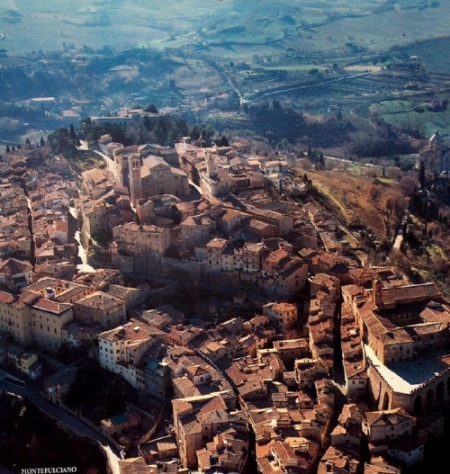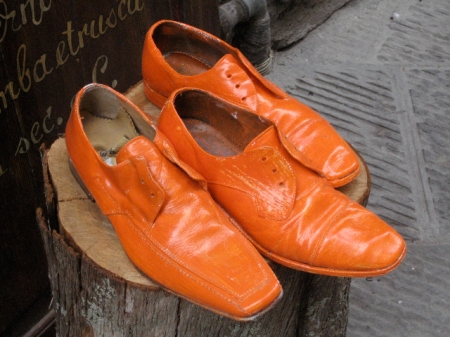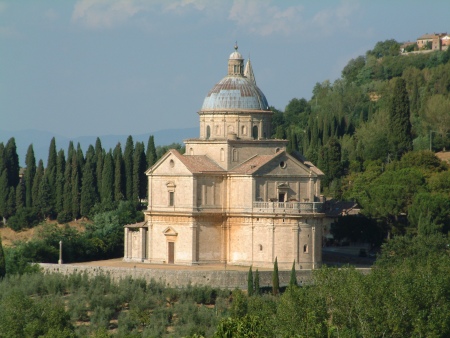Mid-way through our Italian hours and days, we’ll be visiting two towns that, in their different ways, are among the most lovely of Tuscan places: Pienza and Montepulciano. I make this claim even though I have visited neither town. I do so on good authority, though: UNESCO has declared Pienza a World Heritage Site and the surrounding Val d’Orcia a World Cultural Landscape. As for Montepulciano, Bonnie visited in 2008 and reports that it has charm galore.
Here’s a view of Pienza from the Val d’Orcia:
This old hill town was originally named Corsignano, but in the fifteenth century it was renamed and a portion of it rebuilt as an ideal Renaissance city square. This was done at the behest of the town’s most famous son, the diplomat and humanist poet Eneo Silvio Piccolomini (1405-64), who as Pope Pius II envisioned a site of architectural perfection that would be the center of religious and civic life. He renamed the town Pienza, or “Pius,” and commissioned the Florentine architect Bernardo Rossellino to design a complex of buildings, which comprise the first example of Renaissance town planning.
Here’s the plan, with the cathedral forming the central axis and centerpiece of the composition, and palaces flanking it at graceful angles to either side.
Even the well drawn on the plan remains in place, and as the Michelin Guide remarks, its asymmetrical placement amidst all the formality enhances the overall plan.
Here’s a wide-angle view of the complex, which I show even though it is distorted because it so clearly relates Rossellino’s set of buildings to the ideal city . . .
. . . as envisioned by the Humanist architect Leonbattista Alberti:
Entitled The Ideal City (c. 1470), this painting is in the collection of National Gallery of the Marche at Urbino. That’s a long way from Tuscany, but I show it here because it embodies the same ideas of symmetry, order, and balanced architectural forms that the pope envisioned for Pienza. The painting may actually be by Alberti (attribution is uncertain); whoever painted it was closely following Alberti’s ideas about the ideal Renaissance city–rationally designed with spacious plazas between buildings. The jumbled, irregular architecture of medieval towns should be replaced by a new sense of clarity and organization, Alberti argued. Pope Pius II apparently agreed, and he hired Alberti’s pupil, Rossellino, to design a new center for the town he called “Pius.”
After lunch, we head on to Montepulciano . . .
. . . famous for its wine, food, architectural heritage, and shops. In 2008, Bonnie was particularly taken by the store decorated with painted shoes:
Will these still be there? Hard to know, but Italy does have a flair for stylishly accenting its historic infrastructure with contemporary touches.
From 1390, Montepulciano was a loyal ally (and later possession) of Florence, with the result that the Florentine architect Antonio da Sangallo the Elder designed a number of buildings there. One of them is the Palazzo Communale . . . ,
which echoes the Palazzo Vecchio in Florence.
We will be exploring Montepulciano on our own, without a guide, for a couple of hours, and then are scheduled to visit another structure designed by Sangallo, the Temple of San Biagio on the outskirts of town:
A website says this about it: “The travertine church of San Biagio, outside the city, in the countryside, is characterized by a beautiful dome. It is one of the most significance Renaissance works and masterpiece of Antonio da Sangallo the Elder.” It does look lovely–a central-plan church of beautifully proportioned shapes. Here’s another view of San Biagio, which was built in the period 1518-1545:
Though it stands by itself amid trees, its contained geometry and compact forms would allow it to fit in nicely with other structures in Alberti’s Ideal City.
With Sangallo’s lovely structure in mind, we’ll cruise back to Cortona for a nice dinner at our Hotel San Luca. Yes, I’m beginning to dream about Italian cuisine and vino!
Ciao!
RH




 .
. 





